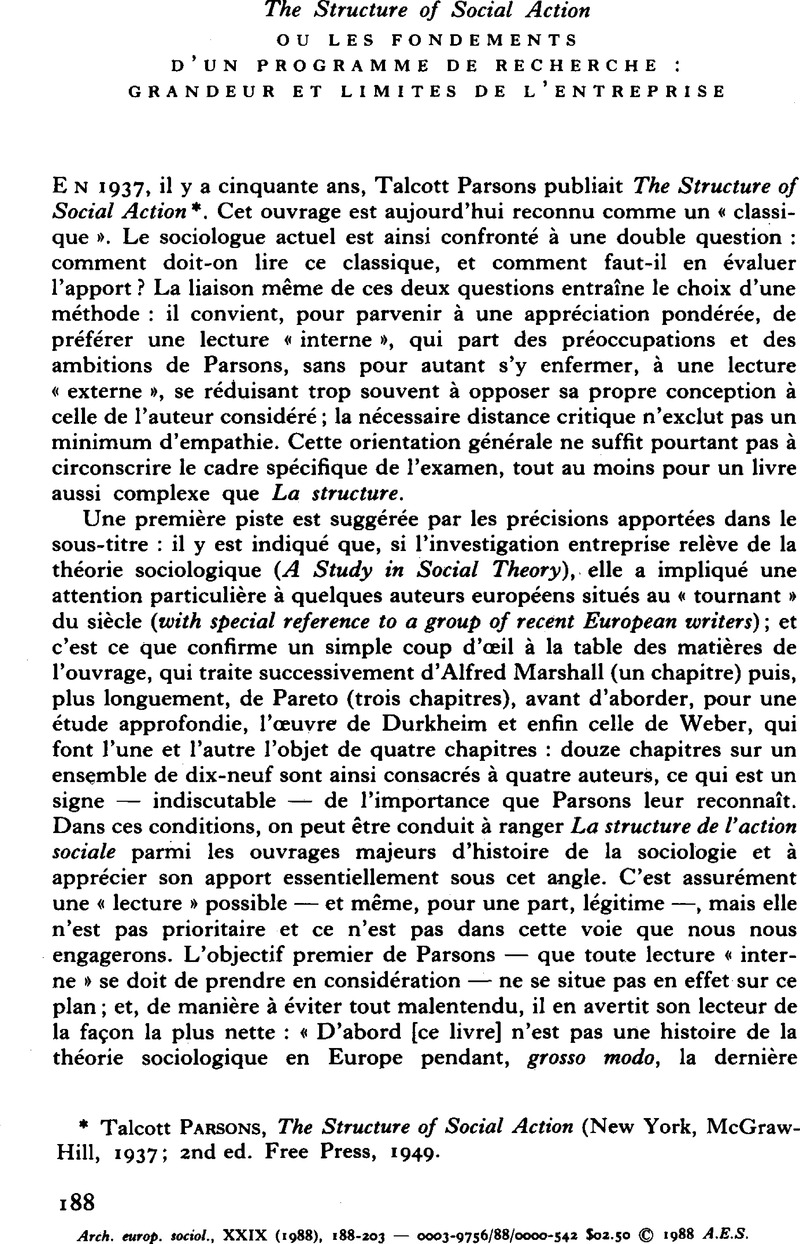Article contents
The Structure of Social Action ou les fondements d'un programme de recherche: grandeur et limites de l'entreprise
Published online by Cambridge University Press: 28 July 2009
Abstract

- Type
- Notes Critiques
- Information
- European Journal of Sociology / Archives Européennes de Sociologie , Volume 29 , Issue 1 , May 1988 , pp. 188 - 203
- Copyright
- Copyright © Archives Européenes de Sociology 1988
References
(1) Parsons, The Structure of Social Action, op. cit., p. 14.
(2) On pourra se reporter sur ce plan à l'article de Pope, Whitney, Cohen, Jere et Hazelrigg, Lawrence E., On the divergence of Weber and Durkheim: a critique of Parsons' convergence thesis, American Sociological Review, XL (1975), 417–427CrossRefGoogle Scholar, et à la réponse de Parsons, quelques mois plus tard, dans la même revue (pp. 666–670).
(3) Martindale, Don, Parsons, Talcott, theoretical metamorphosis from social behaviorism to macrofunctionalism, in Turk, Herman et Simpson, Richard L. (eds.), Institutions and Social Exchange: the sociologies of Talcott Parsons and Georges C. Homans (Indianapolis, Bobbs-Merrill, 1971)Google Scholar; Scott, John F., The changing foundations of the Parsonian action schema, American Sociological Review, XXVIII (1963), 716–735.CrossRefGoogle Scholar
(4) Edward C. Devereux Jr., Parsons' sociological theory, et Williams, Robin M. Jr., The sociological theory of Talcott Parsons, in Black, Max (ed.), The Social Theories of Talcott Persons (Englewood Cliffs, Prentice-Hall, 1961), pp. 1–63 et 64–99.Google Scholar
(5) Alexander, Jeffrey, The Modern Reconstruction of Classical Thought: Talcott Parsons (Vol. IV de Theoretical Logic in Sociology) (Londres, Routledge & Kegan Paul, 1984), pp. 8–11.Google Scholar
(6) Bershady, Harold J., Ideology and Social Knowledge (Oxford, Basil Blackwell, 1973).Google Scholar
(7) Menzies, Ken, Talcott Parsons and the Social Image of Man (Londres, Routledge & Kegan Paul, 1976).Google Scholar
(8) Talcott Parsons, The Structure of Social Action, pp. 6–10.
(9) Talcott Parsons, op. cit. pp. 41–42 (Note on the concept ‘Fact’).
(10) Selon Parsons, la caractéristique fondamentale de l'empirisme est « the identification of the meaning of the concrete specific propositions of a given science, theoretical or empirical, with the scientifically knowable totality of the external reality to which they refer » (op. cit. p. 23).
(11) Whitehead, Alfred North, Science and the Modern World (Glasgow, Collins Fontana Books 1975 [1re éd.: New York, Macmillan, 1925]), pp. 68–75.Google Scholar
(12) Talcott Parsons, op. cit. pp. 28–30.
(13) Ibid. pp. 34 (en italique dans le texte).
(14) Ibid. pp. 745–747.
(15) Cette distinction entre les deux emplois du cadre de référence est présentée par Parsons à la fois au début du chapitre 11 (pp. 48–49) et dans le chapitre final (pp. 731–732).
(16) Le lecteur reconnaîtra ici un thème développé par Max Weber dans L'Ethique protestante et l'esprit du capitalisme à partir de cet exemple.
(17) Talcott Parsons, op. cit. pp. 617–618.
(18) Ibid. p. 607, p. 626.
(19) Ibid. p. 730.
(20) Peut-être vaut-il la peine de citer ici les termes exacts employés par Parsons: la sociologie est définie comme « the science which attempts to develop an analytical theory of social action systems in so far as these can be understood in terms of the property of common-value integration » (op. cit. p. 768).
(21) Savage, Stephen P., The Theories of Talcott Parsons (Londres, Macmillan, 1981), pp. 85–90.CrossRefGoogle Scholar
(22) Harold Bershady, op. cit. p. 71.
(23) Chazel, François, La théorie analytique de la société dans l'œuvre de Talcott Parsons (Paris, Mouton, 1974), pp. 35–39.Google Scholar
(24) Notre ouvrage précédemment cité est, pour une large part, construit autour de ce « mode de lecture ».
(25) Talcott Parsons, op. cit. p. 622.
(26) Talcott Parsons, Review of Bershady, Harold J., Ideology and Social Knowledge, ap. Social Systems and the Evolution of Action Theory (New York, Free Press), p. 133.Google Scholar
(27) Talcott Parsons, op. cit. p. 768, n. 1.
(28) Ken Menzies, op. cit. pp. 34–37. Sinous n'acceptons pas la thèse centrale du livre de Menzies, nous n'en reconnaissons pas moins l'intérêt de certaines de ses analyses.
(29) Talcott Parsons, op. cit. p. 3. Pour une tentative récente de réhabilitation de Spencer, on se reportera à l'article de Boudon, Raymond et Bourricaud, François, Herbert Spencer ou l'oublié, Revue française de sociologie XXV (1984), 343–351.CrossRefGoogle Scholar
(30) Talcott Parsons, op. cit. p. 45: « What is essential to the concept of action is that there should be a normative orientation ».
(31) Ibid. p. 56.
(32) Ibid. pp. 59–60.
(33) Barry, Brian, Sociologists, Economists and Democracy (Londres, Collier-Macmillan, 1970), pp. 76–83.Google Scholar
(34) Talcott Parsons, op. cit. p. 64.
(35) Ibid. p. 58.
(36) Hobbes, Thomas, Leviathan (Paris, Sirey, 1971), p. 48Google Scholar. L'interprétation de Parsons sur ce point est contestée par Warner, R. Stephen, Toward a redefinition of action theory: Paying the cognitive element its due, American Journal of Sociology, LXXXIII (1978), 1322–1323.Google Scholar
(37) Talcott Parsons, op. cit. pp. 92–94.
(38) Talcott Parsons, op. cit. pp. 311–315 (pour la critique de Spencer), pp. 336–338 (pour les implications du concept d'anomie).
(39) Burger, Thomas, Parsons, Talcott, the problem of order in society and the program of an analytical sociology, American Journal of Sociology, LXXXIII (1978), 320–322.Google Scholar
(40) Talcott Parsons, op. cit, p. 732.
(41) Ibid. p. 732.
(42) Ibid. p. 75.
(43) Jeffrey Alexander, op. cit. p. 27.
(44) Ibid. p. 213.
- 2
- Cited by


